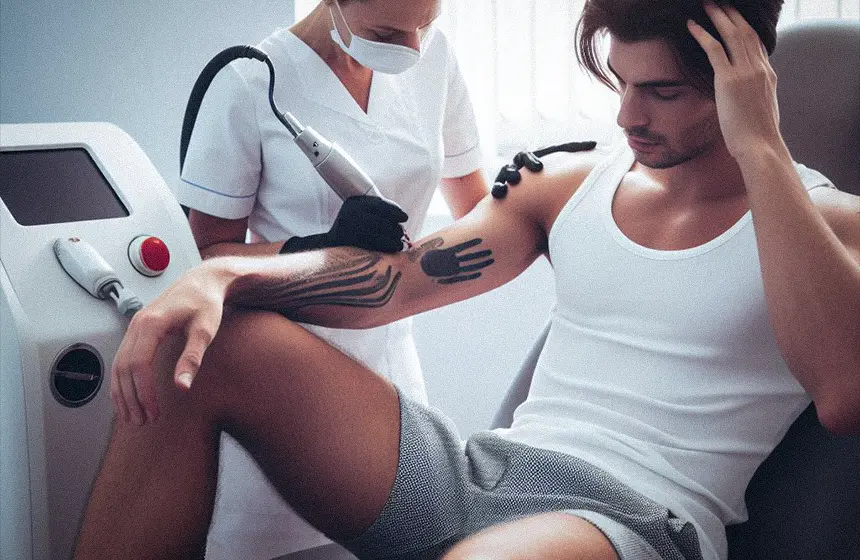You’re ready to bid goodbye to that old tattoo, but there’s one question nagging you – does tattoo removal leave scars?
Let’s put your worries to rest.
This guide is your one-stop shop for tattoo removal, arming you with crucial knowledge about scarring risks and how to avoid them.
You’ll discover preparation tips, post-treatment care, and adherence to treatment schedules.
Remember, your journey is unique, but armed with the correct information, you can navigate it confidently.
Table of Contents
Does Tattoo Removal Leave Scars?
Laser tattoo removal is like getting a tattoo in the first place. When you got your tattoo, your artist probably talked to you about caring for your skin to avoid scarring while it heals.
Treating your skin and its health can affect how well tattoo removal works and whether it leaves a scar. Most people don’t get scars, but it can happen, especially with darker skin. It might be because the skin loses some colour, but it often gets better over time and becomes less noticeable.
Preparing for Tattoo Removal

Before you undergo the tattoo removal process, you must prepare your skin to minimize the chance of scarring. First, it’s recommended to quit smoking as it can impair the healing process. Boost your skin’s health with multivitamins enriched with Vitamin E, aloe, and zinc. Hydration also plays a crucial role in recovery, so drink plenty of water.
Adopt a comprehensive skincare routine, including protection from excessive sun exposure. Effective numbing techniques can also be explored to manage discomfort during the procedure.
Post-treatment, maintain a diligent regimen of washing the area with mild soap, applying recommended ointments and changing dressings regularly. It’s about combining innovative care methods with traditional skin health principles to optimize your tattoo removal journey.
Post-Treatment Care to Prevent Scarring
After your tattoo removal procedure, you must follow several crucial steps to minimize potential scarring.
Scar prevention begins with diligent aftercare. Wash the treated area gently with mild soap and water twice daily. Avoid rubbing the area; instead, lightly pat it dry to protect the newly tender skin. Use an ointment or cream your physician recommends to aid healing and prevent infection.
To further boost scar prevention, change your dressings regularly. This keeps the treated area clean and reduces the risk of infection, a crucial factor in preventing scarring.
If you notice any unusual changes, contact your healthcare provider immediately.
Tips for Daily Washing and Hygiene
Regularly maintaining the cleanliness of the treated area is essential for a swift and scar-free recovery, and you’ll need to be mindful of a few key steps.
Choosing the suitable soap, for instance, is crucial. Opt for a mild, fragrance-free soap to minimize irritation. Harsh, antibacterial soaps can exacerbate inflammation and delay the healing process.
Proper drying techniques, too, play a critical role in recovery. After washing, gently pat the area dry with a clean towel. Rubbing the skin can disrupt the healing process and lead to scarring. Moreover, avoid air drying as it can leave the skin excessively dry and prone to cracking.
Dressing Changes and Scar Prevention
In healing from your tattoo removal, changing your dressings frequently is crucial to prevent scarring. The importance of proper dressing changes must be balanced. A fresh dressing will protect your sensitive skin from bacteria, reducing the risk of infection and subsequent scarring. Here are some tips for minimizing scarring:
| Action | Why it Matters | Tip |
|---|---|---|
| Frequent dressing changes | Keeps the area clean, reducing infection risk | Use clean, non-stick dressings |
| Gentle handling of the area | Prevents damage to emerging new skin | Avoid scratching or rubbing |
| Use of recommended creams | Promotes healing & reduces scarring | Follow your clinician’s advice |
Following Treatment Schedule Importance
You’ll find that sticking to your treatment schedule is one crucial aspect of minimizing potential scarring from tattoo removal. It’s vital to understand the importance of patience throughout this process. The healing process duration varies for each individual, and rushing it could lead to undesirable results.
Your skin needs time to recover between sessions, allowing it to break down and expel tattoo ink naturally. Missing a scheduled session or trying to hasten the process may disrupt your skin’s healing rhythm, increasing the risk of scars.
Frequently Asked Questions
-
What Are the Potential Side Effects of Laser Tattoo Removal?
You’ll encounter side effects post-laser tattoo removal, such as skin discolouration, redness, swelling, and possible infection. Proper post-removal care and understanding of colour implications can minimize these and prevent potential scarring. Consult your doctor for advice.
-
How Effective Is Laser Tattoo Removal in Completely Removing the Tattoo?
You’re asking about removal efficiency in laser tattoo removal. It’s generally effective but varies based on ink colour and skin type. Post-removal care is crucial to avoid residual ink and promote optimal healing.
-
What Type of Laser Is Used in Tattoo Removal, and How Does It Work?
You’re likely considering Q-switched lasers for tattoo removal, which shatter the ink particles, allowing your body to eliminate them. Understand, though, that costs vary with laser types and the tattoo’s complexity and colour.
-
Can the Tattoo Removal Process Cause Any Allergic Reactions?
Yes, ink composition risks can trigger allergic reactions during tattoo removal. It’s rare but possible. Proper post-removal care, including hygiene and professional guidance, significantly reduces these risks. Always consult your removal specialist for advice.
-
Can the Tattoo Removal Process Be Painful, and if So, What Can Be Done to Manage the Pain?
Yes, tattoo removal can be painful, but it’s manageable. Drawing on personal experiences, pain management techniques such as numbing creams, cooling devices, or over-the-counter pain relievers can significantly reduce discomfort.
Conclusion
So, does tattoo removal leave scars?
Not necessarily. With proper prep, attentive post-treatment care, and adherence to your treatment schedule, you can minimize potential scarring. Remember, everyone’s skin is different, and results will vary.
However, with good hygiene, careful dressing changes, and patience, you can navigate this process confidently. It’s all about giving your skin the best chance to heal and recover, leaving you with clearer, scar-free skin.





